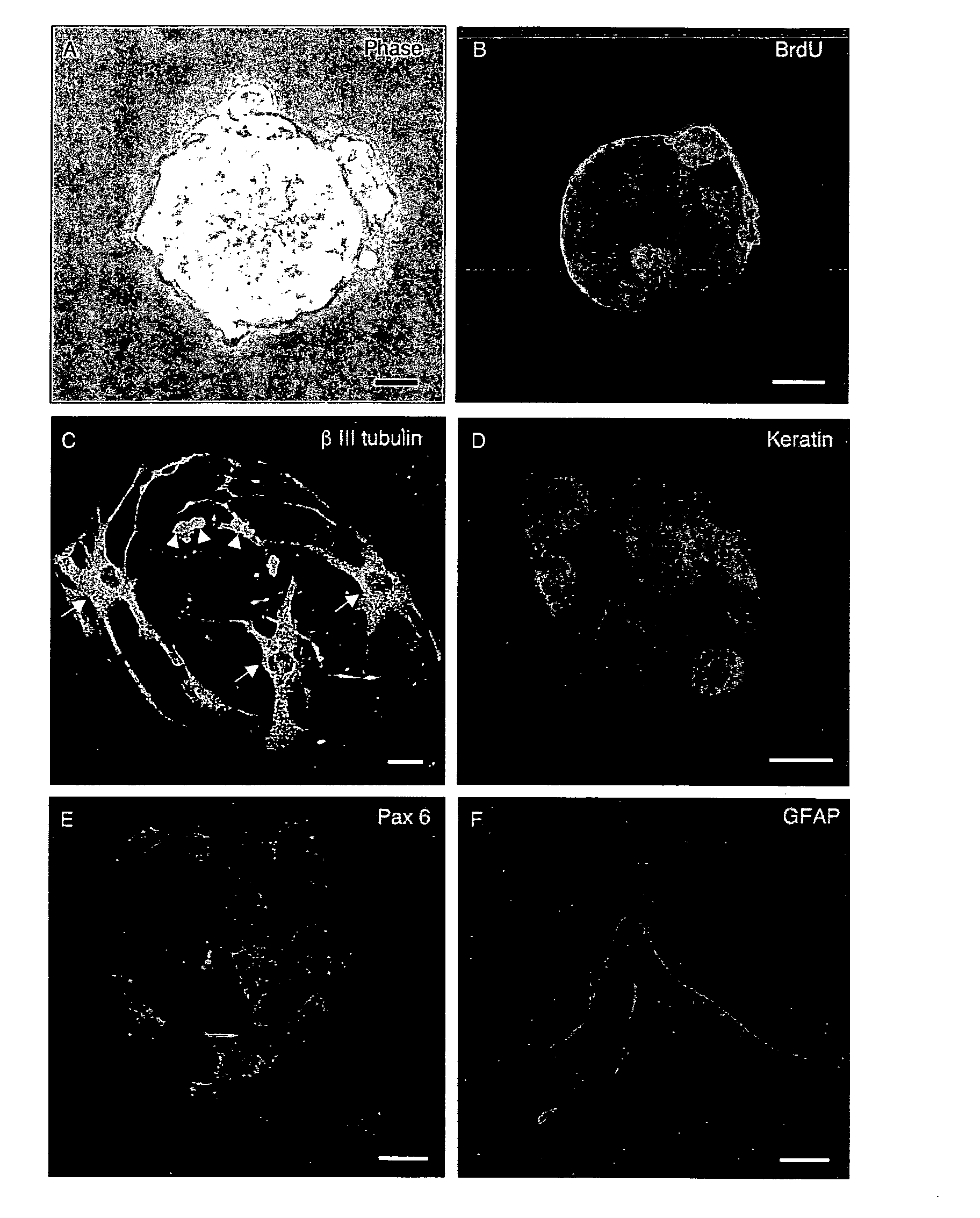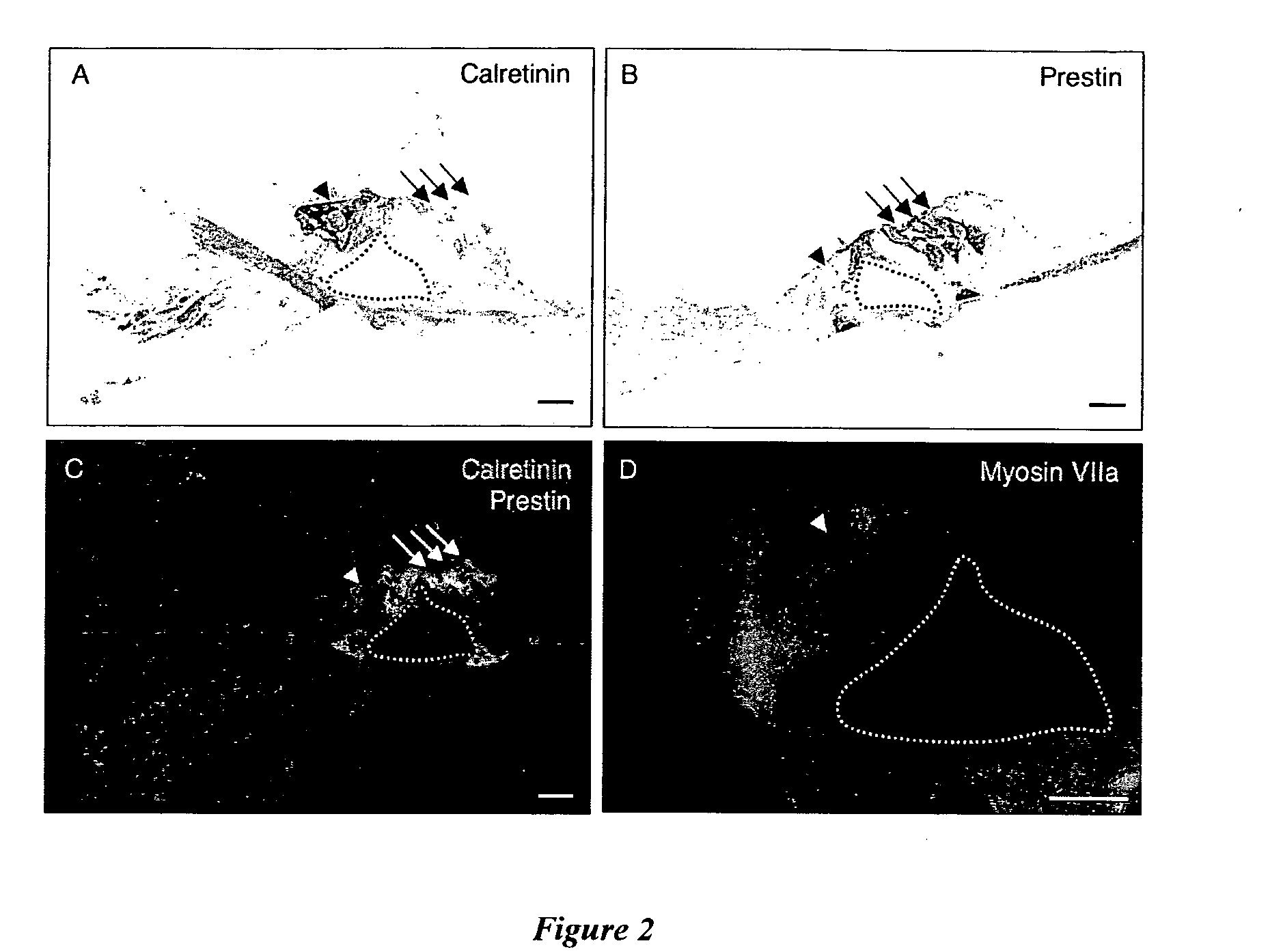Method of treating hearing loss
- Summary
- Abstract
- Description
- Claims
- Application Information
AI Technical Summary
Benefits of technology
Problems solved by technology
Method used
Image
Examples
example 1
Materials and Methods
Primary Adult Olfactory Precursor Cells
[0064]To isolate olfactory precursor cells, olfactory turbinates were dissected from 10-15 adult CBA / CaH mice aged 6 weeks. Mice were anaesthetised with CO2, decapitated and olfactory turbinates were removed and placed in DMEM containing 9.6 mg / ml HEPES buffer. Tissue was centrifuged and supernatant was removed before placing minced tissue into DMEM containing 1% (w / v) BSA (Sigma Chemicals, St Louis, USA), 50 μg / ml DNase (Sigma Chemicals, St. Louis, USA), 1 mg / ml hyaluronidase (Sigma Chemicals, St. Louis, USA), 1 mg / ml collagenase (Roche, Australia) and 5 mg / ml dispase (Roche, Australia) for 1 hour at 37° C. Tissue suspension was triturated, filtered through a 150 μm wire mesh (Small Parts Inc., Miami, Fla., USA), centrifuged and resuspended in Neurobasal medium (Gibco BRL, MD, USA), containing 10% (w / v) dialysed FCS (Gibco BRL, MD, USA), 10000 U / ml Penicillin G (Sigma Chemicals, St. Louis, USA) and 20 mM glutamine (CSL, Me...
example 2
Characterisation of Primary Olfactory Precursor Cells
[0082]Olfactory precursor cells were prepared from dissociated primary cell cultures (n=16) of adult mouse olfactory turbinates. Precursor cells proliferated to form tight clusters of cells (neurospheres) after 24 hours in culture. Neurospheres were typically 100-200 μm in diameter, but could reach 500 μm in diameter (see FIG. 1A). Single round cells radiating from the neurospheres were commonly seen (see FIG. 1A). Some cells within the neurospheres were immunopositive for the BrdU antibody, a marker of the S-phase of the cell-cycle (see FIG. 1B). Trituration of neurospheres and single cell disposition experiments using fluorescence-activated cell sorting (FACS Calibur, BD Falcon, Franklin Lakes, Mass., USA) gave rise to secondary neurospheres, which provides additional evidence that neurospheres were self-replicating (data not shown). Upon removal of growth factors, olfactory neurospheres spontaneously differentiated into cells s...
example 3
Characterisation of Hair Cells in the Organ of Corti
[0083]Hair cells in the adult organ of Corti (cochlea, n=9) were analysed in thin sections of cochlea using markers of inner and outer hair cells. Inner hair cells and spiral ganglion nerve fibres showed positive immunoreactivity to the calcium binding protein, calretinin (see FIG. 2A). No staining was observed in outer hair cells with the calretinin antibody. Outer hair cells were positively labelled with prestin, a transmembrane motor protein present in these cells (see FIG. 2B). Double labelling immunofluorescence shows there was no co-localisation of calretinin and prestin in the adult mouse organ of Corti, confirming the specificity of these antibody markers (see FIG. 2C). Myosin VIIa, a motor protein essential to sensory epithelia, labelled the cytoplasm of the inner hair cell shown in FIG. 2D.
PUM
 Login to View More
Login to View More Abstract
Description
Claims
Application Information
 Login to View More
Login to View More - R&D
- Intellectual Property
- Life Sciences
- Materials
- Tech Scout
- Unparalleled Data Quality
- Higher Quality Content
- 60% Fewer Hallucinations
Browse by: Latest US Patents, China's latest patents, Technical Efficacy Thesaurus, Application Domain, Technology Topic, Popular Technical Reports.
© 2025 PatSnap. All rights reserved.Legal|Privacy policy|Modern Slavery Act Transparency Statement|Sitemap|About US| Contact US: help@patsnap.com



